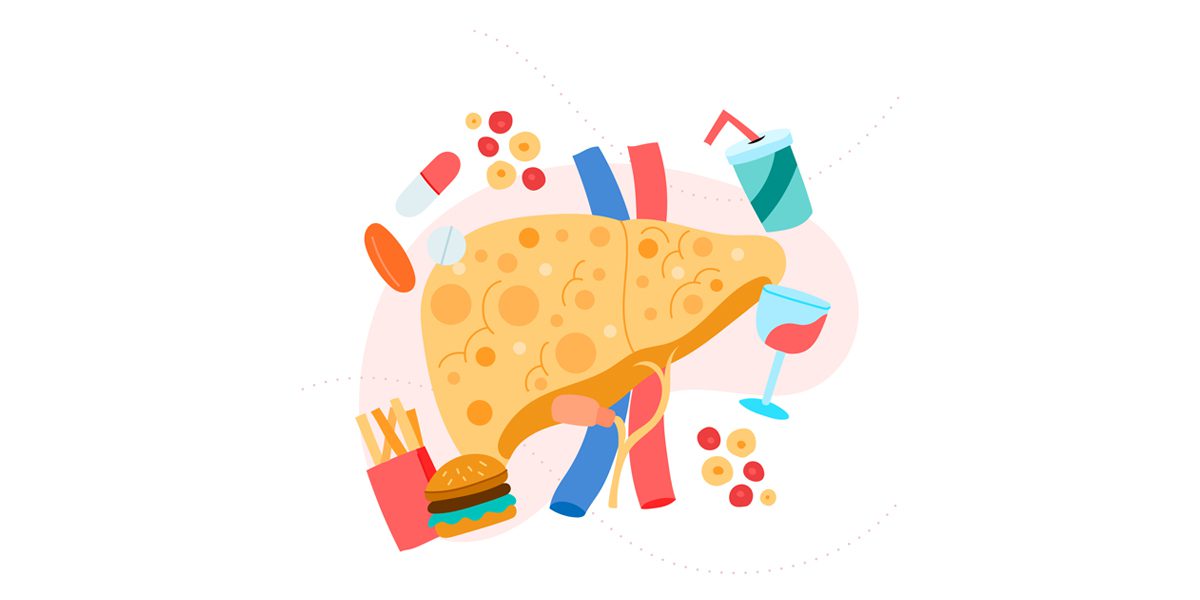Nonalcoholic Fatty Liver Disease (NAFLD) – Symptoms, Causes and Treatment

Did you know that 1 in every ten adults has diabetes worldwide? What’s worse is that scientists believe 700 million people could be affected by diabetes by 2030!
Even more alarming? India saw a 150% increase in people with diabetes in 2020. When treating diabetes, we are not just looking at high blood sugar levels. We also have to manage the many complications that arise from diabetes.
One such complication is NAFLD, full-form nonalcoholic fatty liver disease. Recent studies show that one in every two patients with type 2 diabetes also has NAFLD. With such high risks of complications, you may wonder, what is NAFLD? And how can we avoid it?
Don’t struggle alone & get the expert care you deserve
What is (NAFLD) Non-alcoholic Fatty Liver Disease?
The liver is one of the essential organs in the body. It clears toxins, breaks down fats, helps form proteins, and balances our blood sugar levels.
People who take large amounts of alcohol damage their livers. Fat cells begin to build up in the liver. This is called alcoholic fatty liver disease.
In some conditions, fat cells accumulate in the liver, even without taking alcohol, which causes a range of diseases called NAFLD or non-alcoholic fatty liver disease.
Are People With Type 2 Diabetes at an Increased Risk for NAFLD?
Patients with type 2 diabetes or prediabetes and elevated liver enzymes (ALT) or fatty liver on ultrasound should be evaluated for presence of nonalcoholic steatohepatitis and liver fibrosis.
Diabetes is associated with the development of nonalcoholic fatty liver disease, including its more severe manifestations of nonalcoholic steatohepatitis, liver fibrosis, cirrhosis, and hepatocellular carcinoma .
Stages of NAFLD (Non-alcoholic Fatty Liver Disease)
NAFLD starts with the build-up of fat cells in the liver, which usually doesn’t hamper its function. You may not realize when this happens because there are rarely symptoms.
Fatty liver can be prevented from getting worse if it is detected on time and if you make lifestyle changes to avoid it. If left untreated, it can progress to NAFLD.
After NAFLD, the condition can worsen to cause non-alcoholic steatohepatitis (NASH), where the liver stores extra fat. These fat deposits cause inflammation of the liver tissue.
With time, the liver tissue gets damaged because of persistent inflammation. Nearly 4 out of 10 patients with type 2 diabetes have NASH. As it heals, it forms scar tissue called fibrosis.
This scar tissue is tough and causes the liver tissue to shrink. But it is still able to function normally.
The most severe stage is cirrhosis, where years of fibrosis deforms the liver, making it hard and lumpy. This permanent damage leads to liver failure and liver cancer.
What Are the Causes of NAFLD?
NAFLD has been seen in people who struggle with:
- Obesity or overweight: People who carry a large amount of fat around their middle, with a wide abdominal girth or a characteristic apple-shaped body, are more at risk.
- Type 2 Diabetes, who have trouble regulating their blood sugar levels.
- Insulin Resistance: Their bodies do not utilize insulin well. Insulin is a hormone that helps absorb glucose into our body cells. With insulin resistance, the glucose cannot be used up by the body, leaving high blood sugar levels in the blood.
- Polycystic ovarian syndrome.
- Underactive thyroid gland.
- High cholesterol.
- Elevated blood pressure
- Smoking.
- Metabilic syndrome (a combination of hypertension, obesity, and diabetes)
In rare cases, children are also diagnosed with NAFLD because of a genetic defect that caused them to inherit the disease.
What Are the Symptoms of NAFLD?
During the early stages of the disease, it is challenging to detect NAFLD symptoms.
Fatty liver may be seen on a sonogram, or you may have increased liver enzymes in your blood tests while investigating any other illness or symptom or even during a routine health check.
As NAFLD becomes worse, the liver enters a stage of fibrosis. At this point, NAFLD causes:
- Dull aching pain on the upper right side of your stomach
- Fatigue and weakness
- Sudden weight loss that can’t be explained
- Nausea and vomiting
The most advanced stage of NAFLD is liver cirrhosis, when the liver’s entire structure is damaged. As a result, it cannot function properly, which is why bile builds up in the blood and body.
Nonalcoholic fatty liver disease symptoms include yellowing of the skin and eyes (commonly known as jaundice) and swelling in your legs and ankles (edema).
How Do We Diagnose NAFLD?
- A blood test can help detect elevated liver enzyme levels, which indicate that the liver tissue is damaged. In addition, we can do other tests for liver diseases like hepatitis to rule out any other causes of inflammation in the liver.
- A liver ultrasound can help your doctor assess the amount of extra fat in your liver.
- Transient elastography (Fibroscan)measures how stiff your liver is. Stiffness indicates larger areas of fibrosis and scarring, which means more liver damage.
- Doctors recommend that young people with NAFLD or diabetes and metabolic syndrome get an ultrasound scan of their liver every three years.
- A liver biopsy is an invasive test that removes a tiny sliver of liver tissue with a needle inserted into the right side of your abdomen with the help of a sonogram. The sample is studied under a microscope for signs of liver damage. Studies show that 17% of people with NAFLD and type 2 diabetes have advanced fibrosis on liver biopsy.
- A CT scan or MRI may also help with a NAFLD diagnosis.
How Do We Treat NAFLD?
While no specific medications can help with NAFLD treatment, your doctor may look at other health issues contributing to the disease.
For example, your doctor may prescribe medicines for diabetes, high blood sugar, thyroid disease, and high cholesterol. In severe cases, you may have to undergo a liver transplant if your liver fails.
Lifestyle Habits to Combat Non-alcoholic Fatty Liver Disease (NAFLD)
Changing your diet and activity levels can control your sugar, blood pressure, and weight. These are all risk factors for NAFLD. By adopting a healthier lifestyle, you can manage NAFLD successfully.
Studies show that losing just 10% of your body weight can reduce liver fat and inflammation in the liver tissue. A steady exercise regimen with a balanced diet rich in whole grains, fruits, and vegetables but low in fat and sugar can lead to good results.
Summary
At Fitterfly, we understand the importance of reasonable control over sugar levels and weight. Our customized, evidence-based diabetes management program offer just the right support if you want to bring about lasting changes in your lifestyle.
Check out our website for more information. Or call us on 022 4897 1077 (Ext 1)
Don’t struggle alone & get the expert care you deserve














